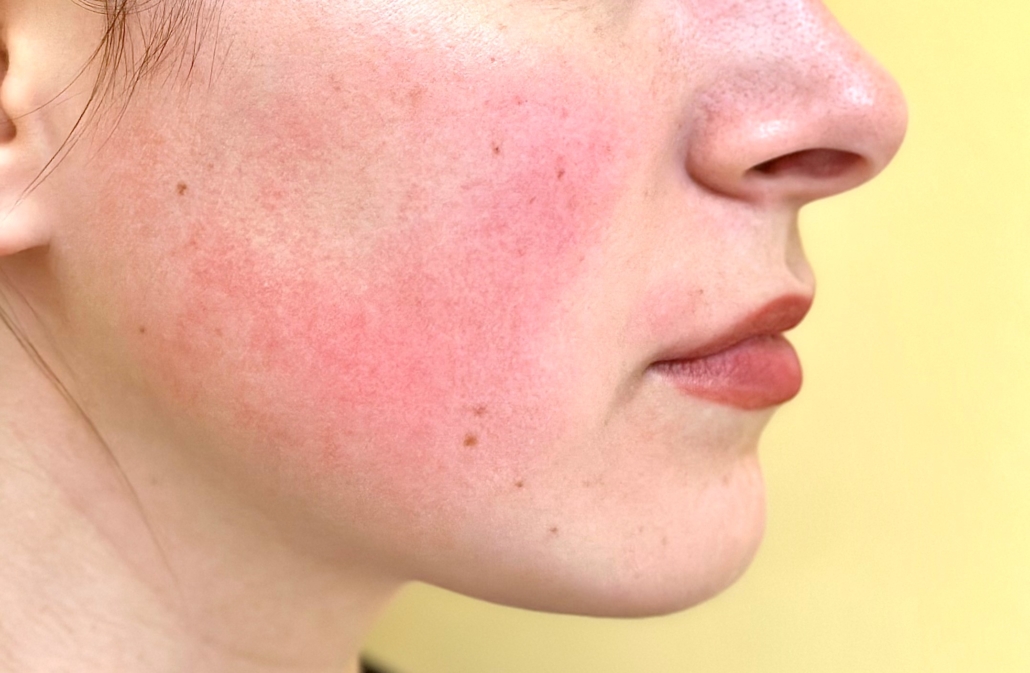Shining a Light on Rosacea

By Laura Monaghan, PA-C
April is Rosacea Awareness Month, dedicated to raising awareness about this common condition affecting around 16 million Americans. What exactly is rosacea, and what are its implications?
Rosacea is a chronic inflammatory disorder that manifests as facial redness, flushing, acne-like bumps, skin thickening (rhinophyma), and eye redness or irritation. Many people experience facial sensitivity, dryness, and a burning feeling in the skin. Eye involvement can include light sensitivity, a foreign body sensation, and crust on the base of the lashes. A patient may have a combination of symptoms and these can vary over time.
Triggers vary and include spicy foods, alcohol, extreme temperatures, sun and wind exposure, exercise, emotional stress, and certain skincare and makeup products.1 It typically manifests between ages 30-50 and is more common in light-skinned individuals but has been diagnosed in Asians, Latin Americans, African Americans, and Africans.2 The central face is usually involved with men more susceptible to skin thickening. Early signs are often overlooked, delaying treatment, which can lead to worsening severity over time. Awareness is vital for timely detection and management.
Rosacea Myths
While rosacea does have many appearances, there are also many misconceptions to clarify:
- Rosacea is NOT due to a lack of hygiene. In fact, heavy scrubbing and exfoliants can further irritate rosacea-prone skin and cause a flare.3
- Rosacea is NOT infectious, despite the implication of Demodex mites. All humans have Demodex mites on their facial skin. Studies show that patients with rosacea tend to carry more Demodex, but there is no evidence that they are a direct cause of the condition.
- Rosacea does NOT mean that a person is a heavy drinker. While alcohol can cause a temporary increase in symptoms, it is not a sole cause of the condition. 3
- A diagnosis of rosacea does NOT mean that a patient is destined for thick, red, and bumpy skin on the nose (rhinophyma). This develops in a small subset of patients with severe untreated rosacea.
Nearly 90% of rosacea patients surveyed by the National Rosacea Society report that this condition has lowered their self-esteem. 41% have even canceled or rescheduled social engagements due to a flare. On the contrary, over 70% report that medical treatment has improved their emotional and social well-being. 3 So, what does treatment entail?
Treatments for Rosacea
A simple place to start is with sun protection and moisturizer as ultraviolet (UV) rays and disruption of the skin barrier are known triggers. Proper sun protection entails using a broad-spectrum SPF 30+ sunscreen and reapplying at least every two hours. Mineral sunscreens that contain zinc oxide or titanium dioxide are preferred because they act as physical blocks. This may help reduce the heat that exacerbates rosacea better than chemical sunscreens.
Gentle cleansers, fragrance-free facial moisturizers that contain niacinamide, and avoidance of irritants such as topical alcohol, witch hazel, and exfoliants can help maintain and repair the skin barrier.4 Some other common treatments include antimicrobial and antifungal agents such as sulfur products, topical ivermectin, topical azelaic acid, topical metronidazole, and oral doxycycline. Other agents including oxymetazoline, brimonidine, and oral beta blockers constrict blood vessels to improve redness.
For severe cases, isotretinoin, or Accutane, or another oral acne medication may also be used. Lasers such as the pulsed-dye laser target redness and dilated blood vessels, providing a longer-term solution. Lasers such as the CO2 and erbium YAG lasers have a role in correcting rhinophyma.5
New Rosacea Treatment Options
There are also several new and exciting rosacea treatments currently in development. First is a series of small injections of Botox® spaced evenly across the face. Preliminary studies show benefit not only in redness and flushing but also in acneiform bumps. Second is oral paroxetine, a selective serotonin reuptake inhibitor typically prescribed as an antidepressant. Evidence shows that serotonin can regulate blood vessel dilation and constriction. Finally, a topical low-molecular-weight heparin sulfate analog (blood thinner) has shown efficacy in reducing inflammation associated with rosacea. These developments are promising for the future of rosacea treatment.6
If you think you may have rosacea, schedule an appointment for further evaluation. Early treatment is key for preventing progression.
Sources
- Mayo Foundation for Medical Education and Research. (2023, October 17). Rosacea: Symptoms & causes. Mayo Clinic. https://www.mayoclinic.org/diseases-conditions/rosacea/symptoms-causes/syc-20353815
- Gallo RL, Granstein RD, Kang S, Mannis M, Steinhoff M, Tan J, Thiboutot D. (2017, January). Standard classification and pathophysiology of rosacea: The 2017 update by the National Rosacea Society Expert Committee. J Am Acad Dermatol. https://www.jaad.org/article/S0190-9622(17)32297-1/fulltext
- Tips for taking action during Rosacea Awareness Month. Rosacea.org. (2022, March 7). https://www.rosacea.org/blog/2022/march/tips-for-taking-action-during-rosacea-awareness-month
- Winter woes – tips for skin barrier maintenance. Rosacea.org. (2023, January 11). https://www.rosacea.org/blog/2023/january/winter-woes-tips-for-skin-barrier-maintenance-rosacea
- Mayo Foundation for Medical Education and Research. (2023, October 17). Rosacea: Diagnosis & treatment. Mayo Clinic. https://www.mayoclinic.org/diseases-conditions/rosacea/diagnosis-treatment/drc-20353820
- McNamara, D. (2024, March). Rosacea: a neurotoxin, an antidepressant, and more emerging options for treatment. Dermatology News, pp. 1–32.







